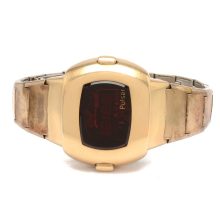How Are Seiko And Pulsar Watches Related?
We often get asked about the Seiko watches and Pulsar watches and more specifically what is the relationship and what are the differences? We’ll discuss a brief history of the brands and a few of the differences between them too.
Seiko was formed in 1881, when a 22 year old man named Kintarō Hattori opened a watch and jewelry shop. In fact, the movements that are used in Seiko watches even today are called Hattori movements, as an honor towards the company founder. In 1892, Hattori began to produce clocks also.
The first watches Hittori created appeared under the Seiko brand in 1924 and while Seiko continued to grow their engineers created many firsts in the watch industry.
For example, in 1969, Seiko introduced the Astron, the worlds first production quartz watch.
In the late 1980s , Seiko produced the first automatic quartz that combined the self-energizing attributes of an automatic watch with quartz accuracy. The watch is entirely powered by its movement in everyday wear.
In 1991 Seiko rebranded their automatic watch and called it Seiko Kinetic which can best be described as an automatic watch on steroids. The Seiko Kinetic watch has the promise to hold a charge up to 6 months from everyday movement simply by wearing it, the same way an automatic watch can be charged.
Seiko now produces quartz, kinetic, solar, and mechanical movements of varying prices.
Pulsar watches were created, like most things, from a vision. A team led by John Bergey of The Hamilton Watch Company designed, developed and launched the Pulsar Time Computer, which was the world’s first digital watch.
In the early 1970s the Pulsar line was a brand of the Hamilton Watch Company which at the time had recently moved their factory from Pennsylvania to Switzerland . At the time, Pulsar watches were a division of the Hamilton Watch Company which belonged to the Buren Watch Company.
Pulsar, the world’s first electronic digital watch, created a sensation when it was unveiled in New York
in 1972 and it changed the world’s perception of time. 
A digital watch is very common today but imagine seeing a digital watch for the first time and how cool that must have been?
The Pulsar Time Computer sold for $2,100, which was more than a new Ford Pinto (think car in Wayne’s World) went for at the time. $2,100 is more than $12,000 in today’s money!
The Pulsar watch was so popular it even appeared on James Bond’s wrist in 1973’s Live and Let Die movie.
Pulsar joined the Seiko Watch Corporation in 1979 leaving the Swatch Group which in 1974 had acquired The Hamilton Watch Company. Once Seiko had brought the brand to the world this enabled the brand to have further growth. Pulsar brought the first calculator watch to the world in 1980 and Pulsar carried the first all-quartz watch line in 1981. By the 1980s Pulsar now had international distribution. In the 1990s Pulsar added new lines including titanium, diamond, and a sports line. Today Pulsar continues to thrive.
Seiko and Pulsar are owned and supported by the Seiko Holdings Group but are marketed differently. Why? They are different price points and attract a different audience because of that. Pulsar watches are typically less money than a Seiko.
Both brands market different ambassadors to their lines too also geared towards different age groups.
It is not uncommon for a company to market similar products, under a different name, to different markets.
Similar to Honda and Acura, in the car industry.
What are some of the differences between the brand?
The cases could be made differently. The pulsar case may have hollowed stainless steel
links where the Seiko links are typically solid throughout.
The movements are both Hittori Japanese quality however you may find more complicated movements in the Seiko line.
Seiko and Pulsar both contain amazing history and are responsible for much of the luxuries we take for granted in watches today. Cheers to them both!
Times Ticking has been in operation for more than 30 years, since 1982. We have performed watch repair for customers both locally and internationally. If it Ticks! We KNOW it! Our team of watch repair technicians have a combined experience in watchmaking of over 120 years.

